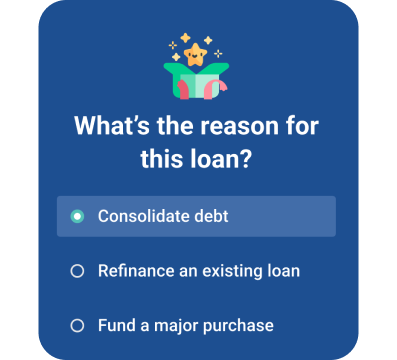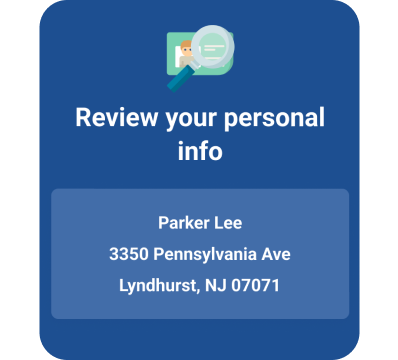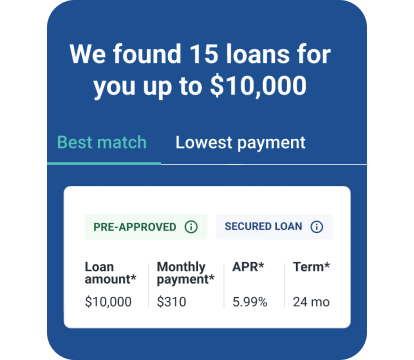If you're in a bind and need money but feel like your options are limited, you may consider turning to a short-term loan. However, short-term loans are often a very expensive way to borrow—especially if you turn to payday loans or car title loans. That's why it's best to consider one of these eight possibilities first.
1. Apply for Credit With a Cosigner
When you apply for credit with a cosigner, the lender takes the creditworthiness of each of you into account. If your cosigner has good credit, you may have a better chance of qualifying. That's because the lender is at less risk. If you miss payments or default on your loan, your cosigner is obligated to pay.
A cosigner may also help you qualify for a credit card or a longer-term personal loan with a more affordable interest rate and better terms. As you repay your loan, your credit score may improve over time so you don't need a cosigner when applying for future credit.
Find a Personal Loan Matched for You
2. Consider Borrowing From Family or a Friend
Asking family or a close friend to help get you out of a jam, cover a few bills or pay one month's rent can be an option to explore. If you miss payments or stop repaying your friend or family member altogether, however, you may risk your relationship. So, before you borrow from a family member or friend, make sure you both are on the same page.
Writing up a loan agreement that outlines how much you'll repay each month and how long you'll take to repay the loan in full may make your relative or close friend feel more comfortable providing the loan. You'll also want to be realistic about how much you really need to borrow so you don't have to ask again.
3. Tap Into Emergency Savings
Tapping into your emergency fund can be an alternative to an expensive short-term loan. While draining your rainy day savings isn't ideal, it's preferable to potentially leaving yourself with pricey interest payments.
If you pull from savings, have a plan to rebuild it so the money is there for future needs. You can do this by trying a short-term savings challenge or temporarily going on a bare-bones budget.
4. Explore Payday Alternative Loans
If you belong to a credit union, you might be able to apply for a payday alternative loan (PAL). A PAL is an affordable option if you need money to make ends meet or to cover an unexpected expense.
The National Credit Union Administration (NCUA) sets guidelines for the rates and terms of PALs. Keep in mind that your credit union cannot offer more than one PAL to you at a time and no more than three PALs total within any six-month period. Also, the credit union may charge an application fee to process the loan.
There are two types of PALs: PAL I and PAL II. The maximum loan amounts vary, but can range from $1,000 to $2,000 with repayment terms of up to 12 months. Although interest rates are comparable with many credit cards, PAL rates are almost always lower than payday loans.
5. Take Out a Secured Personal Loan
A secured personal loan is backed by collateral that you put up to secure the loan, which may be seized if you can't or don't repay the loan. Because secured loans pose less risk to lenders, you may find it easier to qualify for one than for an unsecured loan, even if you have less-than-stellar credit.
Also, because you put up collateral, you may be eligible for a lower interest rate than with an unsecured loan, and you might qualify for a larger amount. That said, collateral loans have their own risks, and it's important to have a strong, reliable plan for repaying the loan.
6. Investigate Payment Protection Plans
Some creditors, utility companies, landlords and mortgage lenders provide payment relief or payment protection plans when customers fall behind because of a financial setback. The relief is only temporary, but it may get you through until you're able to catch up with your missed payments.
Your provider may have an online form you can fill out or you may have to call. Remember, the creditor will begin billing you again when the temporary relief period ends.
7. Explore Personal Loans for Bad Credit
If your credit needs work, you may want to consider a loan designed for bad-credit borrowers. A handful of lenders offer them. However, annual percentage rates (APRs) can be quite high, and you may pay fees. Amounts vary but can range from $500 to $50,000 and may or may not require collateral to secure the loan.
8. Consider a 401(k) Loan
If your employer-sponsored 401(k) plan permits borrowing from your saved funds, this can prove helpful in certain situations.
Most 401(k) loans offer the option to pay off your loan within five years. You can borrow either $50,000 or half of your vested amount, whichever is less. However, if your vested account balance is less than $10,000, you can borrow up to $10,000.
You will pay interest on your loan, and it must be repaid within five years. Keep in mind that by borrowing from your 401(k), you'll lose out on the returns you would have earned on that money and, in many cases, you won't be able to contribute to your 401(k) until you repay the loan.
But if your credit is less than ideal, you know you can repay the loan quickly or retirement is far off, a 401(k) loan may be an option.
Keep Your Options Open
Finding the best alternative to a short-term loan can take time. But it's well worth the effort if it can keep you from digging a deeper financial hole. Maintaining a strong credit score and history is equally important. To see where your credit stands before applying for any alternative to a short-term loan, get your free credit report and credit score from Experian.




